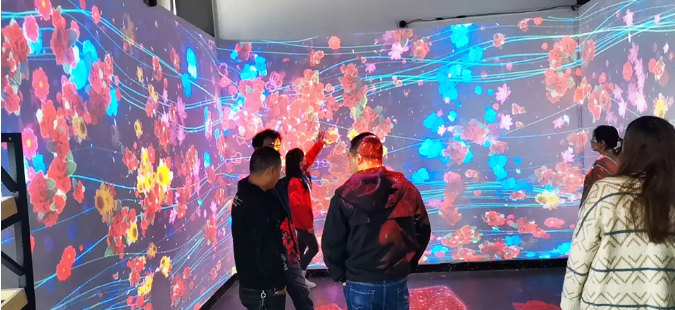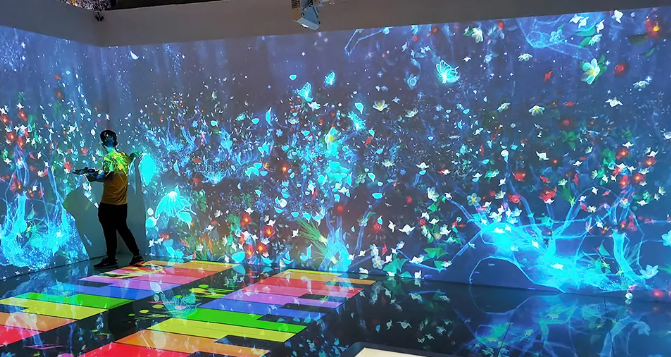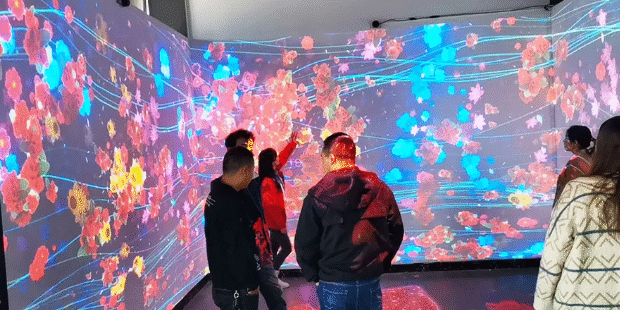What Is an Interactive Wall Projection System?
An interactive wall projection system is an innovative display technology that transforms a flat wall into a large-scale, touch-sensitive surface.
It blends projection mapping, motion sensing, and real-time interaction to create an engaging digital environment that reacts instantly to human gestures and movements.
Whether it’s used in museums, retail spaces, exhibitions, or smart cities, an interactive wall can captivate audiences, encourage participation, and elevate the atmosphere of any venue.

How Does a Wall Interaction System Work?
The system detects participants’ motions through sensors such as radar, infrared, or LiDAR devices, and transmits the captured data to a control host for analysis.
After processing, the system synchronizes this data with the projection software to produce instant visual feedback — allowing users to touch, wave, or move to interact with projected images.
In simple terms, when a participant enters the projection zone or touches the wall surface, the content responds dynamically — creating an immersive “real-world meets digital” experience.
System Composition: Hardware and Software Integration
Hardware Components
- Projectors: Deliver high-brightness, large-area image display.
- Projection Media: Typically wall surfaces, special screens, or curved structures.
- Mounting Systems: Ceiling or wall mounts for flexible installation.
- Control Host: The processing core that analyzes and synchronizes all data.
- Interactive Sensors: LiDAR, radar, or infrared sensors that detect motion and position.
- Cables & Controllers: Ensure stable data and power transmission.
Software Components
- Image Fusion Software: For edge blending, calibration, and visual correction.
- Interactive Content Engine: Provides real-time multi-touch responses.
- Control System: Manages sensor input, animation rendering, and scene logic.
Why Choose CPJROBOT POE LiDAR Interactive Wall System
Unlike traditional camera-based or infrared interaction systems, CPJROBOT’s POE LiDAR solution offers next-generation performance designed for multi-touch precision and easy integration.
Key Advantages
- Multi-Touch Radar Interaction
Supports multiple users simultaneously — perfect for games, exhibitions, and group participation. - No Manual Calibration Needed
The system automatically detects the environment, reducing installation time and ensuring accuracy across any wall size. - Ultra-Wide Detection Angle (270°/360°)
Covers large interactive walls or curved surfaces seamlessly. - Free Interactive Software + SDK Support
CPJROBOT provides more than 100 free interactive games and calibration tools, along with developer SDKs for custom content.

Key Features of Interactive Wall Projection
- Real-Time Human–Machine Interaction: The projected content responds immediately to touch or motion.
- Flexible Adaptability: Suitable for any wall shape — rectangular, curved, or irregular.
- Audience Attraction: Creates visual novelty and encourages crowd engagement.
- Customizable Content: From educational experiences to entertainment games or brand showcases.
Applications of Wall Interactive Projection
Interactive projection walls have become increasingly popular across industries and public spaces, including:
- 🏛 Museums & Science Centers – Educational exhibits and immersive storytelling.
- 🏢 Corporate Showrooms & Launch Events – Brand presentations and product showcases.
- 🛍 Shopping Malls & Retail Stores – Interactive advertising and customer engagement.
- 🧩 Theme Parks & Public Spaces – Large-scale entertainment and crowd attraction.
- 🏙 Smart Cities & Digital Art Installations – Urban innovation and creative expression.
Wherever it is installed, an interactive wall enhances audience engagement, emotional connection, and brand experience.
Projection Form & Customization Options
CPJROBOT supports multiple installation types and projection formats, including:
- Standard rectangular or square walls
- Curved or folded surfaces
- Corner-wrapped or irregular shapes
- Multi-radar cascading for ultra-wide scenes (up to 10 m)
Each system can be tailored to specific venues and project requirements, ensuring perfect image alignment and seamless interaction.
Why Interactive Walls Are the Future
As businesses and cultural institutions increasingly seek immersive and participatory experiences, interactive projection walls stand out as a versatile and scalable solution.
They combine visual art, technology, and engagement into a single interactive medium — turning empty walls into living digital canvases.
With CPJROBOT POE LiDAR, installation becomes faster, performance becomes more stable, and interactivity becomes truly limitless.
Frequently Asked Questions (FAQ)
Q1: What makes LiDAR better than infrared or camera sensors for wall interaction?
A: LiDAR uses laser time-of-flight measurement for high accuracy and works reliably under bright lighting conditions, unlike infrared or vision systems that are affected by ambient light.
Q2: Can multiple LiDAR sensors be used for large-area walls?
A: Yes. CPJROBOT supports multi-radar cascading, enabling continuous interaction across wide or irregular surfaces.
Q3: What kind of software is included?
A: The system includes free calibration tools, an interaction engine, and 100+ pre-installed interactive games — plus SDKs for custom development.
Conclusion
The Interactive Wall Projection System is redefining how audiences experience digital content.
With CPJROBOT’s POE LiDAR technology, any wall can become a fully interactive surface — transforming exhibitions, classrooms, and commercial spaces into vibrant, participatory environments.







